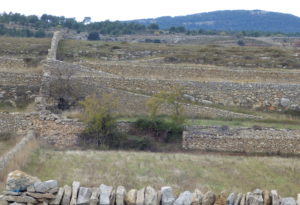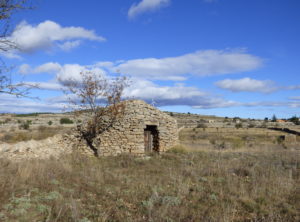DRY STONE
Historical approach to the ethnological landscape around the Volta la Pedra route
Dry stone is a construction technique difficult to study and, in order to achieve a complete vision, it is necessary an interdisciplinary work involving different approaches such as the architectural, the ethnographic and the archaeological. The connection of this technique with the landscape shaped by it is not always treated or interpreted rigorously.
In those sites where the recent anthropization of the environment has been limited by the absence of modern agricultural applications, much of the agricultural, livestock and forestry exploitation system of Vilafranca (Villafranca del Cid), and its dry stone representation, has been preserved. The chronological attribution of this heritage is difficult because some of the studied elements have their origin in the configuration of the Christian medieval land exploitation system which has been maintained (fossilized), with the obvious modifications and short-term adaptations over time.
The physical environment of the municipality has suffered a constant anthropization since at least the Bronze Age, with an important typifying period starting with the Catalonian-Aragonese colonization in the 13th century.
Regarding the landscape, apart from the ethnological elements purely related to the feudal (and/or previous) livestock activity such as the enclosing walls (parets serrades) and the more recent containment walls of terraces created by the agricultural expansion, the most representative ethnological element is the vaulted hut (caseta de volta). This is possibly because of a certain monumentality of its volume and its own aesthetic beauty.
As already noted, the technique is ancient, but not so the works and landscapes that it has helped to shape. In regards to the most intriguing elements of dry stone, the dating of the barracks cannot go back, in the present state of research, beyond the moment of the creation of the current rural landscape, i.e. first half of the 18th century. The vaulted huts, normally associated with the clearing of ancient forests and grazing areas, ceased to be built, in general, in the first decades of the 20th century.vMany of them are now “lost” in areas where the forest has regained its old extension.

Walls that delimit the cattle routes (assagadors), farms and communal spaces, in some cases, could date from the 15th century, when the farm land increased and the need to prevent herds from crossing it was emphasized.
By logic, some elements dedicated to the logistics of the livestock activity (wells, drinking trough, animals’ passageway, pens, etc.) were already necessary in the 13th century, or earlier; however, it is difficult to demonstrate their preservation to the present day in their original state, especially due to the constant maintenance and repair.
Possibly the hardest dating to define is the one of the retaining walls. Although the dry-stone technique has been recorded in archaeological excavations, the dating of retaining walls in the current landscape is still relative, especially in the terraces associated with the most ancient farmhouses, the medieval ones. Easier is the dating of the long and narrow terraces of low agricultural productivity (llastres) because these usually appeared after the middle of the 18th century together with the vaulted huts that were clearly designed as shelter for the animals dedicated to the farming of crops and as temporary or even seasonal human dwelling as they might be equipped with a well, a trough and a door large enough to allow animals inside. The walls enclosing cultivated areas associated with enclosures of communal lands, such as the old pastures at Les Tancades (meaning “closing” or “fencing” in Valencian Catalan) or grazing areas at El Bovalar (from boalar, literally “oxen pastures”), appeared when the use changed from livestock activity to agriculture or when they are no longer so visited.
Finally, it should be noted that, despite the creation of different inventories and catalogues in this regard, the typological characterization of vaulted huts, enclosing and retaining walls still does not provide any chronological information. The data obtained is usually limited, in the best of cases, to functional issues (huts dedicated to agriculture or livestock and walls skirting cattle routes or private properties) in addition to the identification of the element (drain (aigüera), animal passageway, stairs, etc.). Therefore, in order to determine the chronology of the element under investigation, a comprehensive study of the landscape where it is located is necessary.
